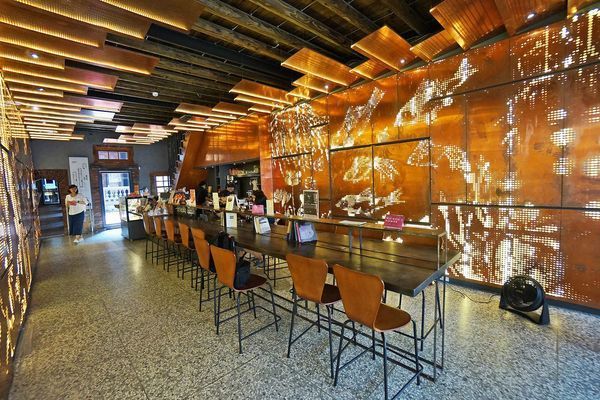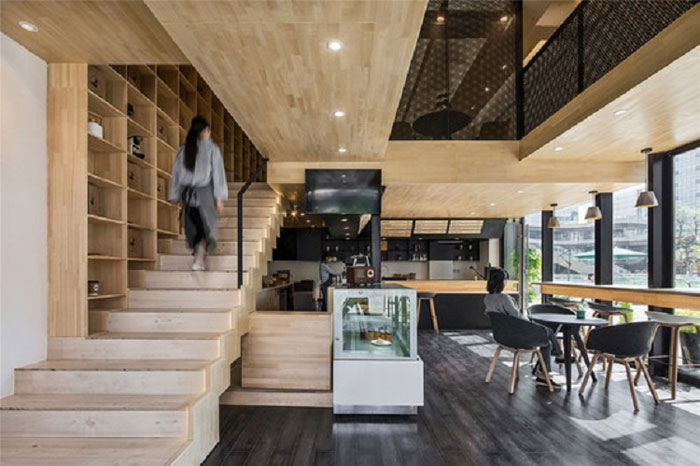Can KFC get rid of the position of "junk food" from "fried chicken" to "coffee"?

For professional baristas, please follow the coffee workshop (Wechat official account cafe_style)
Thirty years ago, when the first KFC opened in Qianmen, Beijing, a large number of people lined up for nearly an hour in the snow to buy a 2.5 yuan piece of original chicken. Today, 30 years later, we complain that the original chicken is too high in calories. I casually ordered a chicken leg salad.
Obviously, in our understanding, KFC is no longer the high-end restaurant that represents the Western-style lifestyle and is suitable for weddings, and even dating to KFC will be regarded as inexplicable.
From "high-end western restaurants" to "popular fast food restaurants", China's KFC is getting closer and closer to its role in the United States, but it seems unwilling to position itself, and it still seems to be trying to make itself more advanced.
From ice cream to light food restaurants, KFC wants to recover the lost "middle class"
According to Dianping, the change in KFC's per capita consumption compared with national per capita consumption between 2008 and 2015: prices have risen year after year, but people's consumption at KFC has basically not changed.
With the Chinese market's ability to contribute more than 30% of its operating profits to Yum each year, KFC can remain attractive to consumers, even if the unit price is lower. After all, it is already an inexpensive fast-food chain in the United States. However, the problem is that KFC, or foreign fast food, has lost its appeal to Chinese consumers. Especially for the younger generation who grew up eating fried chicken burgers, they began to dislike these high-calorie foods and noisy dining environment, and were reluctant to expose their children to these "junk food."
According to a survey released by McKinsey last year, only 51% of the 10,000 Chinese consumers surveyed said they had eaten fast food in 2015, up from 67% in 2012.
Now that it has been rejected, KFC naturally wants to get rid of the "junk food" label.
When the former KFC store opened in 1987, there were only 8 kinds of products on the menu, such as original chicken, mashed potatoes with chicken sauce, shredded vegetable salad, bread, cola, 7-up, Merida and beer. Hamburgers didn't appear until two years later. Now on the menu of KFC, we can see seafood, rice, vegetables, soup, porridge, a large number of localization improvements at the same time, there is also a great trend towards the concept of healthy diet.
However, compared with chicken leg salad, oatmeal bread and crayfish, freshly ground coffee may be the real product line for KFC to upgrade its business.
In 2015, KFC began to sell coffee in China, and used an advertisement to make fun of the high premium of traditional coffee shops, emphasizing that the coffee sold at 10 yuan is the return to the nature of coffee.
But I have to say that KFC's response is still a little slow, considering that old rival McDonald's McCaf é (McCoffee) entered the mainland market as early as 2009, with an average price of around 20 yuan.
From the emphasis on performance-to-price ratio, this "boutique coffee" is still positioned as a more price-sensitive group, avoiding competition with McCoffee and Starbucks (with an average price of about 30 yuan).
In terms of price, last year's popular Hokkaido ice cream Cremia may be a rare "high-end" dish in KFC in recent years. The price of 22 yuan per piece is far higher than that of similar products in the store, and words such as "12.5% cream content", "25% Hokkaido cream", "4 kinds of sugar blend" and "15-sided organ pleated elegant appearance" all interpret the difference of this ice cream.
The change in the dishes may not be obvious enough, so the change in the decoration of the restaurant may better highlight KFC's determination to "upgrade".
Bright red is the usual impression of KFC restaurants, but in recent years, the iconic "KFC red" has been replaced by "high-end tones" such as black and white in some first-tier cities. With drooping downlights, comfortable seats and custom hanging paintings, KFC introduced this "Dining Room" concept in 2014, hoping to allow customers to stay in the store more, which coincides with Starbucks'"fourth space" to create a lifestyle.
The new K Pro light food restaurant in Hangzhou is another attempt by KFC to upgrade fast food. Unlike Dining Room's "abstinence wind", K Pro with green as the main color gives people a more fresh feeling.
The K Pro menu also reflects the "high sense": Hokkaido ice cream, South American white shrimp, Fresh Juice, Belgian lettuce quinoa salad, summer limited crayfish Panini, these dishes hardly show the shadow of KFC, and even the most classic original chicken are packed in small baskets covered with Kraft paper.
After doing so much, has KFC become a little more advanced?
With the refurbishment of the storefront, the transparent production process of K PRO salad and the launch of coffee and beer, it is not hard to see that KFC is trying to move away from its position of cheap fast food and move closer to a simple meal that is more popular with young people, which, in the popular concept, is "fast food upgrade".
However, it is not easy to return to the image of a "high-end western restaurant" 30 years ago. On the one hand, people have formed the inherent impression of "junk food" on foreign fast food, and the real middle class who could afford to eat KFC are now afraid to avoid it.
Even if you are willing to wait in line for an hour to buy more than 20 yuan of Hokkaido ice cream, you may buy a cup of coffee when you order, but it is difficult to associate KFC with the word "high-end". Really pay attention to class, but also can go to a western restaurant, the worst is Pizza Hut ah.
The problems KFC has now are similar to those of Starbucks. Although Starbucks has been working hard in recent years to make breakfast and lunch, telling people that "we are a catering company", people rarely regard it as an option when they need to find a place to eat.
However, according to the importance Starbucks attaches to the food business, there is no guarantee that it will not steal customers from KFC in the future, but it may not be so easy for KFC to get Starbucks' new middle class to come into the store to buy coffee. After all, a dozen pieces of coffee paired with hamburger fries still can't get rid of the feeling of fast food. By contrast, McCoffee, which has a special storefront or even elegant seats, looks much more textured.
On the other hand, although KFC continues to bring forth the new on the menu, its core business is still inseparable from fried chicken, hamburgers and French fries, and most of the other products are only a flash in the pan.
With constantly improving French fries, a variety of refurbished hamburgers, and a 2.5 yuan finger-sucking chicken sacrificed in front of memories, KFC seems to be telling consumers: we know that your favorite food is still these things, so what if it's not healthy? Delicious food is the king.
In addition, although KFC has been plagued by food safety problems in recent years-first the "instant chicken" incident in 2012, and then the "Husi expired meat" in 2014, the bird flu outbreak in 2013 made people "talk about chicken color change". During this period, KFC's performance was indeed hit hard, with same-store sales falling by more than 20% per quarter, but after the incident subsided, KFC gradually recovered. Original-flavored chicken and fried chicken buckets are still the most popular products in the store, and Chinese people who eat food will not have a problem with their own stomach.
As a result, at a time when the performance of the more upscale Pizza Hut is often declining, KFC, with a lower unit price, has always been the best achievement for Yum China.
KFC has to think of other ways to attract young people.
Li Bo, vice president of planning at KFC, has revealed that post-80s, post-90s and even post-00s are their main user groups. Curiosity Daily once pointed out in its analysis that the loss of young users is a problem faced by many fast food brands.
When young people go to McDonald's and KFC, they do not pursue "healthy meals". They only focus on the added value of the brand: convenient and fast service, standardized and safe food, and comfortable dining experience. It is the cool personality, values and brand superiority that accompany the post-80s and 90s who grew up. "
People who like to eat KFC do not care whether the chicken nuggets contain preservatives and whether the eggs are born without cages, while people who pay attention to a healthy life and pursue quality, no matter how you promote the green color of their food, they are also reluctant to step into the door of KFC, which is the embarrassment KFC faces now.
While healthier salads, better ice cream and signing up with fresh meat endorsements can help KFC gain a lot of attention in the short term, it is obviously not enough for KFC to change its brand image and restore its appeal to young people as it did a few decades ago.
Important Notice :
前街咖啡 FrontStreet Coffee has moved to new addredd:
FrontStreet Coffee Address: 315,Donghua East Road,GuangZhou
Tel:020 38364473
- Prev

It means a lot! Walk into the Memorial Cafe with the theme of "comfort Women"
For the exchange of professional baristas, please follow the coffee workshop (Wechat official account cafe_style). As we all know, the cafes in this area of Dihua Street are open indirectly, and they can be said to be competing for each other, each with its own characteristics, but the AMA Caf I want to share with you today is really special. I was attracted by the shining gold light on the wall when I passed by a few days ago.
- Next

Chengdu New Pavilion | Dao Dao Cafe made of logs and metal
Professional baristas Please follow Coffee Workshop (Wechat official account cafe_style) Dao Coffee is located in the center of the commercial district of Yintai City in Chengdu, which is a two-story dessert cafe with an area of about 65 square meters, but at first glance it has a permeability of 200 square meters. The decoration of log color, the sense of line of ferrous metal, and the floor-to-ceiling windows through the sun, designers want to create through these elements.
Related
- What documents do you need to go through to open a coffee shop? coffee shop coffee shop certificate processing process
- How to purchase Coffee beans in small Cafe how to choose a suitable supplier for domestic Coffee supply Company
- How to drink Starbucks Fragrance White Coffee? how to make Australian White Coffee? what Italian coffee beans are recommended?
- The Story of Flora Coffee: the name of Flora Coffee Bean and the implication of the Flowers on Florna Coffee
- How much does a cup of coffee cost? How much is the profit of a cup of coffee? What is the profit of the coffee shop in a year?
- Yunnan small Coffee, known as "fragrant Coffee", introduces the characteristics of Alpine Arabica Coffee producing areas in Yunnan, China
- 2023 latest Starbucks full menu price list how much is a cup of Starbucks coffee what is better to drink the most popular hot and cold drinks recommended
- Starbucks different kinds of Coffee Price list Starbucks menu 2023 Top Ten Best drinks in Starbucks
- Starbucks Spring praise Comprehensive matching Coffee Bean theme Story Packaging implication and taste description
- The cost of a cup of coffee latte American coffee cost price and selling price

